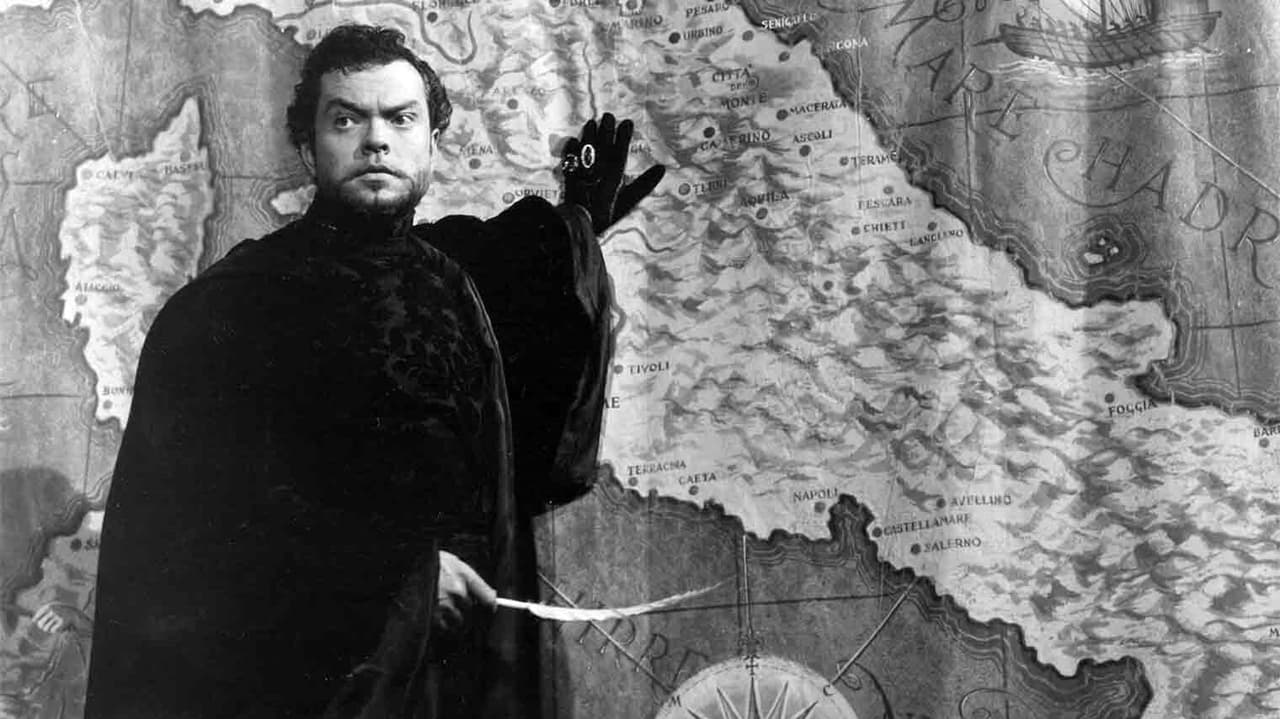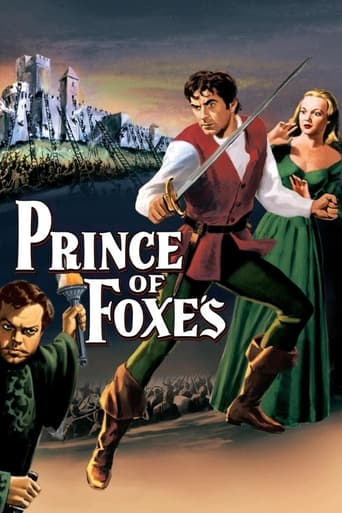

Produced by Sol C. Siegal for 20th Century Fox in 1949 PRINCE OF FOXES is a splendid romantic adventure story set in Renaissance Italy. Stylishly directed by Henry King on actual Italian locations it has one unforgivable drawback - its Monochrome cinematography! So for once I cannot say - for the life of me - in glorious black & white! For if ever a movie needed to be filmed in colour PRINCE OF FOXES is the prime example! One story has it that there was not adequate funds to film in colour. But the preferred excuse was when the company arrived in Italy in 1948 to begin shooting they found that there was not a colour camera to be had in the entire country. And being behind schedule already the unfortunate decision was made to film in Monochrome. But Fox Video should have made an effort in making some kind of amends for this by colorizing the movie for this DVD release, thereby preserving - to some degree - the scenes in the magnificent ornate palaces and churches of the Renaissance whose interiors were used in the picture. After all they had done an excellent job with colour on the DVD re-release of the classic "The Mark Of Zorro" (1940) a couple of years back, surely PRINCE OF FOXES was a more deserving cause! Ironically the only Acadamy Award nomination the picture garnered was for Leon Shamroy's Monochrome cinematography!As it stands however it is still a fine movie with a cracking screenplay by Milton Krims based on the novel by Samuel Shellabarger. Tyrone Power is excellent in it and brings great depth to an already well written part. Also there's a striking performance by Orson Welles in the plum role of Cesare Borgia. The story involves a young adventurer, Andrea Orsini (Power), who is appointed as a sort of ambassador by Borgia to some kingdoms he hopes one day to acquire. When he goes to a mountain state ruled by the kindly and elderly Count Verano (Felix Alymer) and his attractive much younger wife Modonna Camilla (Wanda Hendricks) he becomes aware of a better way of life. He turns against the Borgias, is imprisoned and tortured (in a startling sequence his eyes appear to be gouged from his head). Later he is freed and leads a revolt routing the Borgias. Finally the old count dies from his battle wounds leaving Andrea and the young widow free to marry.Despite the shameful absence of colour Shamroy's Monochrome cinematography does however lend King's well told story a certain visual style. Also an outstanding addition to the overall picture is Alfred Newman's ravishing baroque score. After the exhilarating Main Title music there is the sumptuous main theme. First heard hauntingly sung by solo male voice over the Venice canal sequence it is then fully developed in glowing orchestral form and is used to point up the growing love between Andrea and Modonna Camilla. An exquisite broad rapturous theme full of engaging warmth which positively surges with passion. It is arguably Alfred Newman's loveliest melodic inspiration! This dazzling score can be heard for its own merits isolated on the audio track.Performances in PRINCE OF FOXES are throughout generally well played with Power and Welles being particular standouts. Excellent also is Felix Alymer and Everett Sloane but Wanda Hendricks in the female lead is terribly miscast. She doesn't suit the picture at all! One wag observed "She looks like a bobbysoxer lost in a great Cathedral". My sentiments exactly!The DVD is of exceptional quality! With well defined imagery that is sharp and clear. Extras, besides Newman's arresting score, include a still gallery, a good trailer and a very appropriate Movitone News excerpt showing Ty Power and Linda Christian being wed in Italy which took place while he was making the movie there. NICE ONE FOX! BUT IT IS A SHAME YOU DIDN'T COLOURIZE IT!
... View MoreThis is historically beautiful? This is melodrama at its miserable-best.Tyrone Power stars in this awful picture about a man sent out to do the work for the evil Cesare Borgia, only to find love and turn on him. The script is quite weak here and some of the acting, particularly by Wanda Hendrix, as his true love, is churlish and almost laughable. Hendrix was horribly cast in this treacherous soap-opera like atmosphere.Everett Sloane goes from bad to evil and repeats the cycle in record time. He is the embodiment of evil with that look of his. Nevertheless, it is not exactly a memorable performance such as that of Bernstein in Welles'"Citizen Kane."Katina Paxinou, who had been supporting Oscared 6 years before for the memorable "For Whom the Bell Tolls," comes along for the ride as Power's hysterical ultra-religious mother. She definitely had a tendency to over-act which she displays here.Welles is his usual terrific self as the evil Borgia, but the script does him in. Also, the black and white cinematography creates a dull period atmosphere-like film. Color would have been somewhat of an enhancement with better writing coming along.
... View MoreIf passionate love, convivial betrayals and loyalty one can change as quickly as one's shirt intrigues you, you'll most likely enjoy Prince of Foxes. If nothing else, you'll learn a great party trick that involves two eyeballs and two thumbs. Prince of Foxes, in my view, is one of the best of the Tyrone Power adventure films. It stands out in part because we find ourselves operating in the lusty, double-dealing world of Cesare Borgia. And while Orson Welles, who plays Borgia, can't resist slicing the ham with gusto, it must be admitted that he brings a lot of joie de vivre to villainy. Andrea Orsini (Tyrone Power) is one of Borgia's clever lieutenants. He's smart, charming, deadly with a blade and almost as opportunistic as his master. As Borgia says when describing the kind of man he needs for a mission to Ferrara to undermine the duke there, "who but a man as quick at deceit as a fox? He must have the grace of a dancer, the wrist of an assassin. He must have little regard for good faith, yet by his astuteness be able to confuse men's minds....He must charm as a snake charms birds, yet he must make no friends, except for those who may be of use to him, and for the same reason although he may make use of love, he must not love." His mission to Ferrara a success, Orsini is sent by Borgia to secure the fortified Citte del Monte, ruled by the aged and honorable Count Verano (Felix Aylmer) and his much younger wife, the Countess Camilla (Wanda Hendrix). Orsini brings with him the unscrupulous and deadly rogue Mario Belli (Everett Sloane). Poor Andrea Orsini. As he witnesses wisdom and humanity, as for probably the first time in his life he begins to feel an honorable love, and as he knows Cesare Borgia will soon arrive with an army to demand the capitulation of Citte del Monte, he discovers that most uncomfortable of feelings...a conscience. Before long a good man will die, love will blossom, a great battle will be fought, a rescue from a dungeon will be planned and executed, the difference between conscienceless nobility and the nobility of the soul will be pointed out to us, and two eyeballs will be put in danger. The movie, filmed in Italy, is briskly paced and well photographed. The battle scene is a rouser, with fat, stubby cannons blasting away. Great wooden trebuchets hurl stones and flaming balls of pitch into the city. Vats of boiling oil are tipped over onto Borgia's soldiers as they try to scale the city's walls. The screenplay is studded with clever, cynical observations about love, diplomacy and war. Unlike so many adventure movies, there really is no dud acting in Prince of Thieves. Even Wanda Hendrix manages the role of Camilla with enough dignity to win us over. The cast of featured players is strong, with solid performances by Felix Aylmer, Marina Berti as a cousin of Cesare who has her eye on Orsini, Katina Paxinou as Orsini's peasant mother and, especially, that first-rate actor Everett Sloane as Mario Belli. He went to Hollywood from the Mercury Theater with Welles and appeared notably in Welles' Citizen Kane and The Lady from Shanghai. He gets perhaps the best lines in the movie: "I discovered that the devil doesn't always pay best. This whole thing pleases me. Who betrayed who and where did it start? No matter. It shall be said among my fellow practitioners in double-dealing that I was the greatest of them all." But what of Cesare Borgia? The movie implies that the forces of justice will rise up one day and smite him. In fact, Borgia was the illegitimate son of Cardinal Rodrigo Borgia, who became Pope Alexander VI. When his father became Pope, Borgia's career as a military conqueror blossomed. When the Pope died, Cesare discovered all his old friends quickly found new men to fawn over. After being imprisoned once or twice, he made his way to Spain, where he was killed in a battle against French forces most people have long forgotten.
... View MoreYou have to understand that Samuel Shellabarger who wrote Prince of Foxes and Captain from Castile, along with several other sabre-rattling novels of the renaissance, was a very popular writer in the 40s and this movie captures much of the romantic mood of his novels. Tyrone Power had appeared earlier in Captain from Castile which had been a hit and this effort including the great Orson Welles as Cesare Borgia, and two great character actors, Katrina Paxinou and Everett Sloane, was a fantastic production. Wanda Hendrix, who was never any great shakes beyond presenting a pretty Hollywood face, did not distract from the film but the scene chewing between Power, Sloane and, of course, Welles (before he became so obese), is classic. Power with his dark handsome Irish face was always delightful in these heroic roles tinged with darkness. Recall that this film was of the same time period as his classic Nightmare Alley. It is an entertaining yarn but, alas, no video or DVD at this writing, so you'll just have to look for it on the late show. Do so because if you like the romantic golden oldies with a bit of swash and buckle, you'll dang sure like this one.
... View More